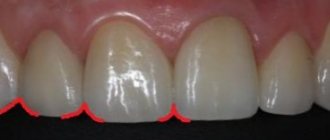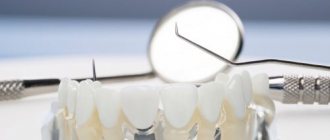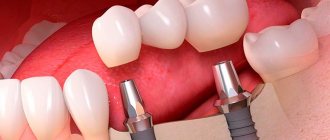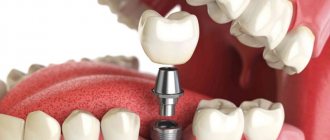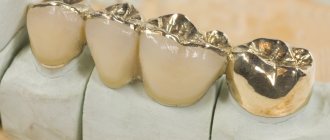Indications and methods for artistic dental restoration
Artistic restoration of teeth
This is a method in which the natural structure of the tooth is restored by copying dental tissues with various materials. Restoration can be carried out to change the position of teeth, to change their color and to eliminate existing defects.
Video example of restoration of anterior teeth (incisors) with composite material (eng)
Video of restoration of the upper canine with composite material (eng)
Dental restoration is a treatment whose indications are the presence of caries, any non-carious lesion of the tooth (fluorosis, enamel erosion, abrasion of the surface of the teeth, etc.), chips and cracks, gaps between teeth, enamel pigmentation, as well as incorrect positioning of teeth in dentition. At the moment, there are direct and indirect methods of dental restoration. Which method will be used depends on the problem that needs to be fixed and your wishes.
Direct dental restoration
It is performed directly in the dentist’s chair using special restoration materials. The convenience of this method lies in the fact that in one visit to the doctor you can solve your problem and enjoy a beautiful smile. However, there are cases when indirect dental restoration may be necessary; the prices for dental services in this case will be significantly higher than for direct restoration. This restoration method involves the production of thin porcelain or composite plates - veneers.
Indirect dental restoration
Now it is accepted as very high quality, since it requires making the most accurate shape of the material for your tooth in the laboratory. Due to this, such similarity with natural dental tissues is achieved.
Dental restoration techniques are used differently depending on the chosen restoration method. They differ in that with the indirect method, this technique takes place in several stages. With the indirect method, two visits to the doctor are required, taking an impression, installing a temporary filling, fitting, and only then installing the restoration material.
Our specialists will select the most suitable restoration method for your specific case and answer all questions that may arise. Teeth restoration before and after photos will show you what effect our doctors achieve.
Extension technique
Restoration of dental organs through extension is carried out using filling materials. This way you can easily remove chips and damage.
Note: The advantage of this method is that there is no need to grind down the tooth.
In addition, this procedure is quite inexpensive compared to other methods.
Heliocomposites, reflective compounds and photopolymers can be used as filling materials. These materials belong to a new generation, restoration with them gives high-quality and effective results. Their aesthetics are at a high level. When using them, the enamel is not damaged, there is no rejection, since such composites adapt well to living teeth.
The color of such fillings does not change over time. The composition of heliocomposites and photopolymers is highly similar to the composition of tooth enamel. The transparency of teeth can also be imitated through the use of such materials.
Such filling substances also contain fluorine and a very durable special filler, which allows you to restore teeth both after mechanical damage and those destroyed due to improper metabolism.
It is also important that the tooth remains in place; its nerve is also not removed. In addition to restoring the destroyed anterior dental organ, the composite can also correct its size and shape, as well as hide age spots and old fillings.
New materials for extensions can make teeth as natural, healthy and strong as possible, and a perfect smile.
What materials are used for dental restoration?
Dental restoration is the restoration of a chipped, broken or partially destroyed tooth by caries or in some other way. The materials used for dental restoration depend on which method was chosen. For direct restoration, the dentist uses composite materials (photopolymers); indirect restoration is longer and more expensive, because this method requires time to make a veneer from ceramic mass.
Dental restoration with composite materials has many adherents around the world. The development of aesthetic dentistry allows the use of the latest restoration materials, which helps patients not be embarrassed about their smile after just a couple of visits to the doctor. Photopolymers, which have found their application in the restoration process, are very convenient to work with, because they very easily take the desired shape. Composite dental restoration allows you to change the color of a tooth, restore and change its shape, and close the gaps between teeth.
Prices for dental restoration using photopolymer composite will depend mainly on the degree of damage to the tooth, the chosen treatment method and the composite material used. Dental restoration using filling material is in many ways inferior to restoration using veneers. Over time, this material may darken, lose its shine, and if the tooth is severely damaged, such a restoration can be destroyed under the influence of external factors.
Composites used
Light composites have many features regarding the restoration of anterior teeth. They are primarily plastic, so they have a number of disadvantages. Let's consider the main ones:
- Unstable effect. As a result of eating, brushing teeth and constant mechanical impact on the teeth, composites used in restoration gradually lose their shine. They can also fade, become rough and even begin to scratch. As a result, food dyes can linger on the enamel, which will change the color of your teeth.
- The low strength of the composite can cause them to chip after five to seven years, and the filling may no longer fit tightly to the tooth, forming a stained stripe between itself and the tooth and contributing to the development of caries.
- Most of these materials are not sufficiently similar to natural fabrics. In such cases, even a highly qualified doctor will not be able to make the tooth so that it is not at all different from the rest.
- The lack of fluorescence can cause composite areas to appear as holes due to ultraviolet light hitting the teeth.
Of course, composite materials also have advantages. Let's look at their main positive qualities:
- Quick and easy installation. There is no need to take impressions, as happens when using veneers, and wait for the structures to be made. The entire extension procedure takes place in one visit to the dentist.
- Affordable price.
- Possibility of correction.
- There is no need to grind down living tooth tissue; only caries and old fillings are removed.
Sequence of the dental restoration process
There is a certain sequence in which the restoration procedure is carried out. This methodology must not be violated, otherwise you will not get the desired result. So, the stages of dental restoration:
- Preparation for the restoration procedure. The tooth surface is mechanically cleaned, anesthesia is applied if necessary, and the tooth is isolated from saliva using a rubber dam.
- Tooth preparation. Removing pigmented enamel, softened dentin and cleaning teeth from caries.
- Gasket application. It is necessary to protect the pulp from possible exposure to the composite.
- Etching dentin and enamel. It is necessary for the sterility of the surface of the cavity and promotes better adhesion of the hard tissues of the tooth to the composite.
- Applying primer to the surfaces of enamel and dentin. Makes dentin airtight, thereby limiting it from any external influences due to clogging of dentinal tubules.
- Application of composite and its plastic modeling.
- Composite polymerization. Hardening of the composite material.
- Final processing of the restoration. The surface is modeled and formed after restoration.
- Carrying out control tests and correction of restoration work.
- Surface polishing.
- Final polymerization.
Stages
Let's consider the main stages of artistic restoration:
- Preparatory stage. The doctor cleans the teeth of stone and plaque, selects the color of the composite that best matches the shade of the enamel. If necessary, anesthesia is administered.
- Removal of affected tissue using a drill. If a filling has already been placed on the tooth, it is also drilled out.
- Next, the doctor isolates the dental organ from the patient’s wet breath and saliva. For this purpose, today they use a rubber dam, that is, a latex scarf stretched over the teeth, in which there are holes for the teeth. If moisture gets on the composite, the marginal seal of the filling may be disrupted, which can again provoke caries. The composite can also deform or fall out under load or on its own.
- If there is significant damage in the crown part of the tooth (more than 1/2), a pin can be placed in it; the bark helps strengthen the filling. For teeth in the smile zone, fiberglass pins are used, thanks to the transparency of which the front dental organ will look natural.
- Then the doctor applies the composite material, creating a layered restoration. In this case, a small amount of composite with different shades and transparency is applied in layers, which will then allow the tooth to look natural.
- Processing of a tooth for the purpose of final modeling of its shape. For this purpose boron is used.
- Then the doctor grinds and polishes the surface of the dental organ.
Alternative restoration
Restoration of the tooth crown
Can be produced in various ways. Our clinic offers them all. This can be traditional dental filling, covering the tooth surface with veneers, restoring the anatomical shape of the tooth using a crown, or any existing method of prosthetics (implants, inlays, etc.). The main task of the dentist is to choose and offer the patient the most optimal method of tooth restoration.
Dental restoration with veneers
This method will be acceptable in the following cases:
- treatment of chipped teeth;
- getting rid of a small gap between the front teeth;
- changes in enamel color that cannot be bleached in any other way;
- changes in the shape of the tooth crown;
- changes in moderate curvature of teeth.
Dental restoration with inlays
It is used for minor tooth damage, when restoration of 1-2 sides is necessary. There are restorative (restore the shape and color of the tooth) and stump (a crown is then placed on top of them) inlays. Inlays can be made of metal, ceramics, metal-ceramics, as well as composite and all-ceramic.
If your tooth is more than half destroyed, and even more so if the nerve in it has also been removed, then it is recommended to install a crown. They are ceramic and metal-ceramic. Service life, aesthetics and reliability are superior to conventional restoration methods.
Sign up
How is dental restoration performed?
Artistic restoration of teeth consists of the following stages:
- first, anesthesia is performed (this step can be skipped if the defects are small);
- then the doctor treats the defect site (damaged tissue is removed, the tooth surface is roughened to ensure further adhesion to the material used for restoration);
- the dentist selects the material taking into account the shape and color of the object that will be restored;
- direct restoration is performed (recovery of lost tooth fragments);
- Together with the patient, a comfort check is carried out, if necessary, corrections are made (the doctor adds or removes restoration material);
- final polishing is carried out.
Contraindications for dental restoration procedures
- The patient has an incorrect bite.
- Absence of a certain number of chewing teeth.
- The presence of a disease - bruxism.
- Monolithic destruction of the inner enamel of the tooth.
- Unnatural tooth wear.
- Passion for dangerous sports (for example, boxing).
However, some indications can be treated, so the possibility of restoration should not be abandoned forever. You can cope with bruxism or correct a malocclusion and then contact us for dental restoration.
Why is tooth stump restoration necessary?
Tooth stump restoration is used in dentistry to restore a badly damaged tooth to a degree that allows the tooth to be prepared for installation of an artificial crown. Recently, dentists have been actively using the direct method of restoring the tooth stump (pinless method), which uses special composite materials. Very often, when a tooth is severely damaged, only the root remains and for greater support, it is necessary to install a pin (pin method). The mouth of the canal is widened, treated, filled, and only after that can a pin be installed.
There is also another way to restore a tooth stump - a cast stump inlay. This is a custom made metal post that restores the portion of the tooth above the gum. This is a monolithic alloy that has no seams or joints, which gives it greater strength and resistance to heavy loads.
Price
Thanks to the affordable price, today every patient can have their teeth restored. After the procedure, a person gets a perfect smile, which improves his mood and relationships with others. The price for such a procedure depends on the condition of the teeth, how many of them need to be treated, what method of restoration will be used, the materials used, the qualifications of the doctor and the status of the clinic.
In terms of price, artistic restoration is inferior to restoration with veneers. At the same time, thanks to a wide selection of composite shades, you can make the tooth as natural as possible. It is important to carefully select the material. It is clear that a composite that is too cheap will not last long.
The total price, including all preparatory stage procedures, is approximately 5-6 thousand rubles for the direct method and 8-20 thousand rubles for restoration with veneers.
Let's consider the prices for each item of the restoration procedure using the direct method:
- pain relief - 200-300 rubles;
- insulation from moisture using a rubber dam - approximately 350 rubles;
- sterility kit (gloves and doctor’s mask, shoe covers, bib and sterilization of instruments) - 100 rubles;
- restoration of the crown with a light composite - 3.5-4 thousand rubles;
- installation of a pin - 1.5 thousand rubles when using a fiberglass pin, which is more acceptable compared to installing a metal pin that can be seen through the composite.
If the entire crown of the tooth does not need to be restored, then there is no need to install a pin, and the restoration will cost approximately 3 to 4 thousand rubles. If you only need to fix a chip on the cutting edge of the incisor, you will need to pay the dentist approximately 1.5 - 2 thousand rubles.
Artistic restoration of anterior teeth
Dental restoration in Moscow today is available to everyone, and it is especially important for that part of the teeth that we show to others. Artistic restoration of the front teeth requires good skills from the dentist not only from a medical, but also from an aesthetic point of view. This type of restoration is the most popular because people want to smile without embarrassment. Restoration of the anterior group of teeth by specialists at our clinic today is able to correct any tooth defects from chips and cracks to giving the natural color of tooth enamel.
There are direct and indirect restoration of anterior teeth. Only consultation with a specialist can help you choose one of these methods. In the first case, reflective filling materials are used. This process is based on layer-by-layer application of photopolymer material, which requires the skill and experience of a doctor. This method can be used for minor damage to the tooth, as it is subject to abrasion over time. Restoration of the frontal group of teeth, when choosing an indirect method, is based on the work of the doctor, which consists of observing several rules:
- correct selection of the color of the desired material for the veneer;
- using the correct tooth preparation technique;
- taking impressions of the front teeth;
- installation of temporary and then permanent veneer.
Restoring the front teeth with veneers will be appropriate if, after some dental procedures, it is no longer possible to achieve color by whitening. They can also be used to slightly correct the shape of your teeth. Depending on the manufacturing method and material, veneers are divided into therapeutic ones made of composite material and orthopedic ones made of ceramics. Only a qualified dentist can tell you which type you need. The effect obtained from this method of restoration can be seen in the photo before and after restoring teeth with veneers.
Few people think about the fact that when we talk or laugh, the lower part of the teeth is always visible. Therefore, restoration of the lower teeth is extremely important and simply necessary for a healthy and beautiful smile. Also, a very large load is placed on the lower row of chewing teeth, which contributes to the frequent formation of chips and caries. Therefore, you need to understand that artistic restoration of chewing teeth is important not only from a practical, but also from an aesthetic point of view.
Aesthetic restoration of the front teeth from below and above is necessary, first of all, for people who have problems with their teeth, but want to be self-confident and not be afraid of communicating with other people.
Ceramic veneers
Despite the fact that veneering has appeared quite recently, this procedure already has many fans. After all, ceramics have almost no disadvantages. It will not fade or change its original color over time.
It is advisable to use ceramic veneers in the following cases:
- the need to restore the front tooth by more than 1/3 of it;
- What is important is the long-term effect of the restoration, which will not lose its aesthetics over time;
- if necessary, remove the cutting edges.
Veneers will allow teeth to become light, not different in texture from their neighbors. Unlike composite materials, even after years (at least 3) they will remain in their original form, without darkening or staining. That is, their use is more practical and durable.
In this case, the choice in favor of veneer or composite material should remain with the specialist. After all, only the doctor knows what is best for the patient in his particular case. The dentist should tell the patient about both methods of restoration, including their cost, so that he can also participate in the choice, if any.
Restoration of the chewing group of teeth
The main goal pursued during the restoration of lateral teeth is the restoration of their functionality, that is, the restoration of chewing function. Restoration of lateral crooked teeth is necessary for several reasons.
Firstly, excessive curvature of the teeth can tear the gums, thereby causing discomfort and pain when eating.
Secondly, an incorrect bite can lead to incorrect redistribution of the load on the teeth.
Third, wide and flat surfaces will cause severe tooth wear and reduce chewing efficiency.
All these factors can negatively affect the general condition of all teeth. Therefore, during restoration, reproduction of the individual characteristics of the tooth, including macrorelief, all tubercles and pits, plays a very important role. You should monitor the health of all teeth without exception, not paying attention only to those that are visible when you smile.
When is it better to refuse to correct your bite with veneers?
Like any intervention, veneering has limitations. The pads are not suitable for people suffering from bruxism. Grinding your teeth can ruin all your work. You should not install pads if you have the following pathologies in adults:
- periodontitis 3-4 degrees (teeth are very loose, gums are inflamed);
- thinning of enamel;
- significant damage to the crown (from 40%);
- lack of teeth in the area of prosthetics;
- severe curvature.
Sometimes it is possible to place veneers on crooked teeth after the condition improves or certain conditions are met. So, in case of infections, pregnancy, childhood, you just have to wait.
Restoration of baby teeth in children
Today, even a child can have a tooth restored in our clinic. Restoration of a baby tooth is necessary in case of injury or extensive carious destruction. This method allows you to completely restore the anatomy of the crown of a baby tooth, which will allow you to preserve it until it is naturally removed and replaced with a permanent tooth. Do you think saving a baby tooth makes no sense?
You are wrong, because the health and well-being of baby teeth has a direct impact on the condition of permanent teeth. Plus, a baby tooth that falls out unnaturally can cause deformation of the dentition. After all, if the permanent tooth has not pushed it out, but the gums are empty and the neighboring teeth may begin to move. In addition, premature tooth loss can lead to deterioration of diction, changes in bite, increased load on neighboring teeth, which can also fall out prematurely and many other negative consequences. Thus, we come to the conclusion that the need for restoration of temporary teeth should not be ignored by parents. Timely intervention by a dentist in the problem will help avoid complications in the future.
Your teeth are like new again!
Restoration (full or partial) of the front teeth will help restore your teeth to their lost shape, shine, color and whiteness. At the SKYDENT dental clinic in Novosibirsk you can get prosthetics or trimming at an affordable price.
Using modern composite materials and various medical linings made of metal-ceramics in practice, dentists restore the dentition, giving it its original appearance.
Artistic restoration of the front teeth is not only aesthetically attractive, it is also confidence. A radiant smile can be compared to a newly restored airplane, which, against the backdrop of an old aircraft, attracts the attention of passengers and delights pilots.
Aesthetics in dentistry
In our society, a beautiful snow-white smile has already become not just a sign of health and well-being, it is good manners. That is why cosmetic dental restoration in Moscow is now so popular. Now it is customary to sparkle with the whiteness of your perfectly straight teeth and even decorate them with precious stones.
Aesthetic dental restoration involves giving the ideal appearance of the tooth, its color, shape and structure. In the hands of a professional dentist, restorative materials transform teeth into works of art. Since modern aesthetic restoration implies the complete elimination of any changes and defects on the surface of the tooth. This is exactly the kind of modern dental restoration on Vernadsky Avenue (Yugo-Zapadnaya metro station) that is available to everyone. Our clinic’s specialists will advise you and tell you what types and how restoration of tooth color, enamel and shape occurs. They will advise you on prices and explain what results you should expect from each specific restoration method.
In order to achieve a beautiful shape and durable dental covering, our dentistry uses high-quality composite materials. These materials come in a huge variety of colors to give the teeth a natural appearance and similarity to the patient's other teeth. Restoring the shape of teeth allows them to return their functionality, as well as make the size of the teeth more suitable to each other from an aesthetic point of view.
Aesthetic restoration of anterior teeth is designed to give a natural shape to the tooth line. It is known that teeth darken with age, and teeth with a removed nerve also have this unpleasant property. The color of enamel is negatively affected by eating foods that have coloring properties, as well as smoking. In modern dentistry, there are many teeth whitening systems. Restoration of tooth enamel can be carried out using any of them or by applying special lumineers and veneers.
You can contact our clinic and get all the information you are interested in about how artistic dental restoration works. Our prices are quite reasonable, and the quality of the services provided makes you come back to us again and again.
Aesthetic dental restoration video shows how the procedure takes place in the clinic.
What is better – correcting crooked teeth with veneers or braces?
Comparing these treatment approaches is difficult. Braces correct malocclusions, and veneers mask defects.
| Veneers | Braces | Aligners (aligners) | |
| Tooth preparation | The enamel is removed to a depth of 0.2-0.7 mm | Not carried out | Not carried out |
| Duration of treatment | Up to 2 weeks | Up to 2 years | Up to 3 years |
| Severity of defect | Lightweight | Deep | Deep |
| Diet changes | For 2-3 days | Yes, all the time of treatment | No |
| Care | No special care required, just be careful when using it | Careful hygiene required | Careful hygiene required |
When they say that veneers correct the bite, they mean the aesthetic aspect. Braces and aligners eliminate deep violations.
The best material for teeth is ceramics
Ceramics have been used in dentistry for many years and are very successful. Dental restoration with ceramics is the best way to achieve an invisible and high-quality result. Dental restoration of teeth requires not only the correction of teeth from an aesthetic point of view, but also the elimination of more serious defects. Crowns, veneers, lumineers, bridges, etc. are made from this material.
Lumineers are made from high-strength pressed ceramic. They are resistant to mechanical damage, look very natural and are durable. This is an ideal replacement for regular teeth whitening.
Ceramics also have another very important quality - a wide range of colors. Choosing the right color is not difficult, since the choice is large, you can find all natural shades of teeth.
Now you have access to high-quality ceramic dental restoration at Yugo-Zapadnaya. To do this, you must come to us, here you will be pleased not only with the quality of the services provided and the professionalism of the staff, but also with the cost. Tooth restoration in Moscow at the ARTOX clinic is fast, high-quality and inexpensive .
Our specialists know first-hand what dental restoration is. You can find reviews about all restoration methods on the Internet, but you should not completely trust them. Only professional diagnostics and consultation with a doctor, a specialist in this field of dentistry, can provide you with a complete picture of the treatment and tell you how justified a particular restoration method is. The main thing is to be sure who you trust with your health.
And don't forget that regular visits to the dentist and good oral hygiene will help you prevent many dental problems. Well, if they do arise, then you must immediately seek qualified medical help in order to avoid complications. Our clinic is always ready to come to your rescue and provide quality treatment at affordable prices.


